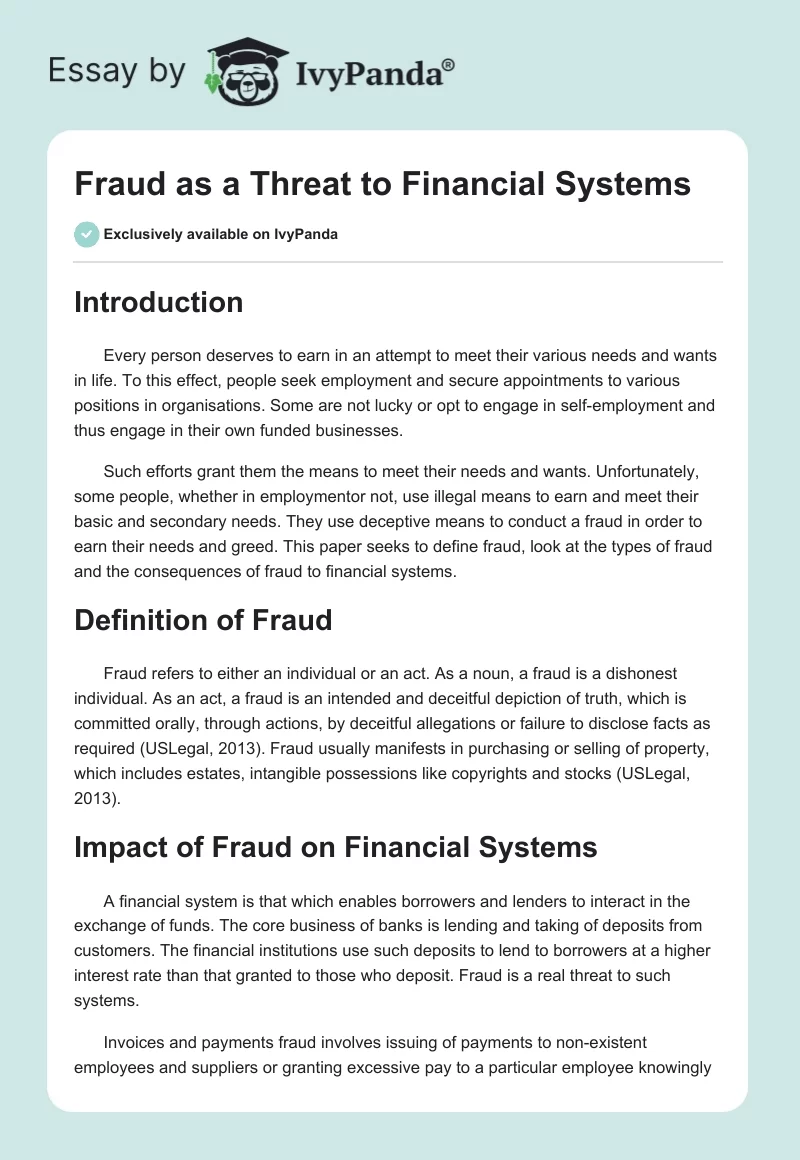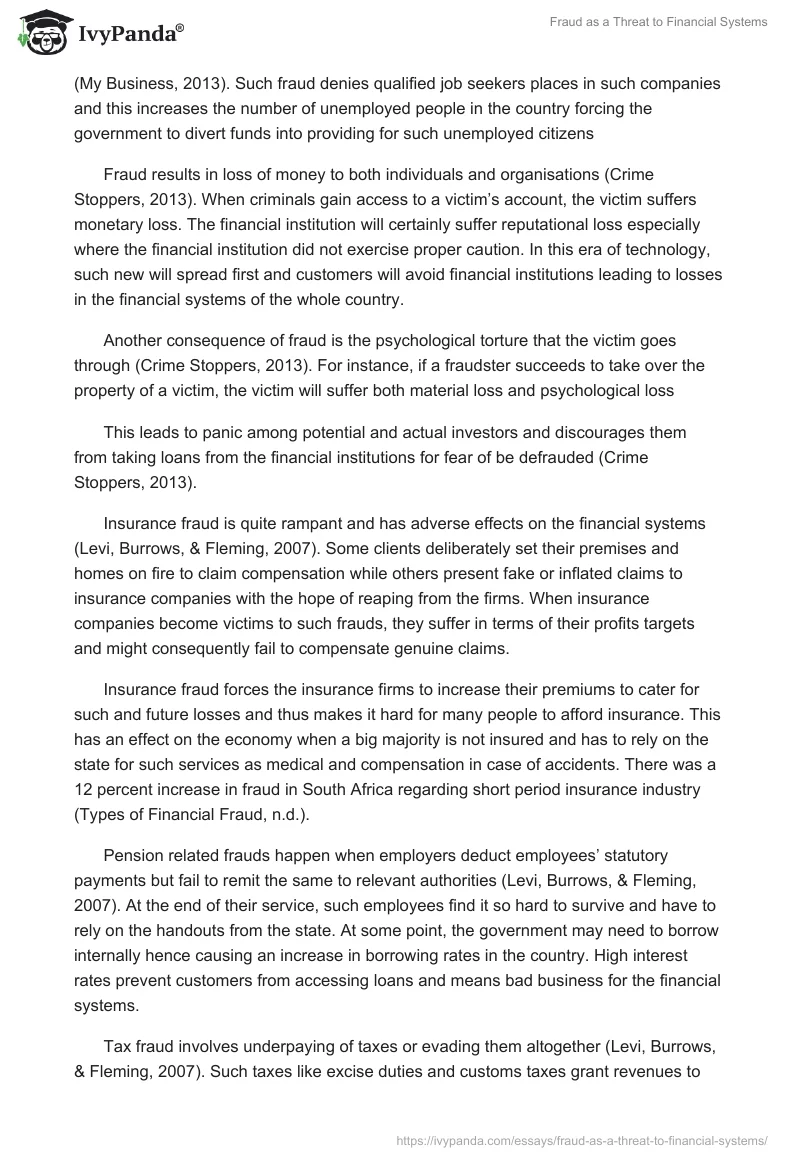Introduction
Every person deserves to earn in an attempt to meet their various needs and wants in life. To this effect, people seek employment and secure appointments to various positions in organisations. Some are not lucky or opt to engage in self-employment and thus engage in their own funded businesses.
Such efforts grant them the means to meet their needs and wants. Unfortunately, some people, whether in employmentor not, use illegal means to earn and meet their basic and secondary needs. They use deceptive means to conduct a fraud in order to earn their needs and greed. This paper seeks to define fraud, look at the types of fraud and the consequences of fraud to financial systems.
Definition of Fraud
Fraud refers to either an individual or an act. As a noun, a fraud is a dishonest individual. As an act, a fraud is an intended and deceitful depiction of truth, which is committed orally, through actions, by deceitful allegations or failure to disclose facts as required (USLegal, 2013). Fraud usually manifests in purchasing or selling of property, which includes estates, intangible possessions like copyrights and stocks (USLegal, 2013).
Impact of Fraud on Financial Systems
A financial system is that which enables borrowers and lenders to interact in the exchange of funds. The core business of banks is lending and taking of deposits from customers. The financial institutions use such deposits to lend to borrowers at a higher interest rate than that granted to those who deposit. Fraud is a real threat to such systems.
Invoices and payments fraud involves issuing of payments to non-existent employees and suppliers or granting excessive pay to a particular employee knowingly (My Business, 2013). Such fraud denies qualified job seekers places in such companies and this increases the number of unemployed people in the country forcing the government to divert funds into providing for such unemployed citizens
Fraud results in loss of money to both individuals and organisations (Crime Stoppers, 2013). When criminals gain access to a victim’s account, the victim suffers monetary loss. The financial institution will certainly suffer reputational loss especially where the financial institution did not exercise proper caution. In this era of technology, such new will spread first and customers will avoid financial institutions leading to losses in the financial systems of the whole country.
Another consequence of fraud is the psychological torture that the victim goes through (Crime Stoppers, 2013). For instance, if a fraudster succeeds to take over the property of a victim, the victim will suffer both material loss and psychological loss
This leads to panic among potential and actual investors and discourages them from taking loans from the financial institutions for fear of be defrauded (Crime Stoppers, 2013).
Insurance fraud is quite rampant and has adverse effects on the financial systems (Levi, Burrows, & Fleming, 2007). Some clients deliberately set their premises and homes on fire to claim compensation while others present fake or inflated claims to insurance companies with the hope of reaping from the firms. When insurance companies become victims to such frauds, they suffer in terms of their profits targets and might consequently fail to compensate genuine claims.
Insurance fraud forces the insurance firms to increase their premiums to cater for such and future losses and thus makes it hard for many people to afford insurance. This has an effect on the economy when a big majority is not insured and has to rely on the state for such services as medical and compensation in case of accidents. There was a 12 percent increase in fraud in South Africa regarding short period insurance industry (Types of Financial Fraud, n.d.).
Pension related frauds happen when employers deduct employees’ statutory payments but fail to remit the same to relevant authorities (Levi, Burrows, & Fleming, 2007). At the end of their service, such employees find it so hard to survive and have to rely on the handouts from the state. At some point, the government may need to borrow internally hence causing an increase in borrowing rates in the country. High interest rates prevent customers from accessing loans and means bad business for the financial systems.
Tax fraud involves underpaying of taxes or evading them altogether (Levi, Burrows, & Fleming, 2007). Such taxes like excise duties and customs taxes grant revenues to the government and if people evade them, it denies the government the revenue it needs for its development projects. The financial systems, too, get to suffer because such evaders may never borrow funds since they import goods at relatively low prices that do not require borrowing from the financial institutions.
Lending fraud involves a customer presenting fake import documents to obtain letters of credits from the financial institutions and withdrawing such funds for personal use (Levi, Burrows, & Fleming, 2007). It might also take the form of a supplier issuing goods to a bankrupt company without prior knowledge.
When this takes place, financials systems suffer losses and tighten the process of borrowing making it harder for other borrowers and this in turn affects the whole economy, which largely depends on such people who borrow to engage in economic activities.
Charity fraud involves embezzling of funds meant for charitable organisations with total disregard to intended beneficiaries (Levi, Burrows, & Fleming, 2007). This has a negative impact on the economy, which to some extent depends on such development projects to compliment what the government is doing. In addition, such organisations offer employment to the locals and thus decrease the rate of unemployment.
When a borrower is defrauded, the victim finds it hard to keep on servicing the debts and mostly results in defaulting on borrowings (Types of Financial Fraud, n.d.). This means bad debts to financial systems and consequently, loss when such debts are irrecoverable. Such a customer finds it hard to survive and has to rely on the state for support. This increases the pressure on the state and the state chooses to borrow further to cater for such needs.
Conclusion
Fraud is a crime that takes different forms and has adverse effects on the global economic financial systems. When financial systems engage in fraud, customers lose trust in them and shun them. Such financial systems have trouble in operating since their lending business goes down and they cannot realize projected profits.
Insurance fraud is threatening the average person since such companies have increased the price of their premiums to take care of the fraud directed at them.
Relevant authorities must act swiftly to prevent fraud. In addition, legislation must be in place spelling stiff penalties for fraudsters since they really affect the financials systems, which are a backbone to the economy. Financial systems too, must engage their employees and discourage them from such acts of fraud to guard their integrity and maintain their businesses.
References
Crime Stoppers. (2013). Fighting Fraud. Web.
Levi, M., Burrows, J., & Fleming, M. H. (2007). The Nature, Extent and Economic Impact of Fraud in the UK. London: Cardiff.
My Business. (2013). Four types of financial fraud and how to stop them. Web.
The Free Dictionary. (2013). Legal Dictionary. Web.
Types of Financial Fraud. Web.
USLegal. (2013). Definitions. Web.


